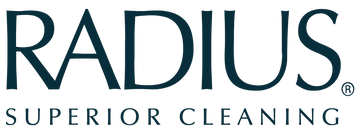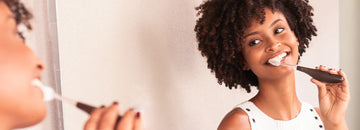Floss, brush, rinse, repeat…what’s so hard about that?
Most of you reading this already know the basics of oral care….but is there more to it than that?
Yes.
From proper brushing technique to the right time to floss to how often you should really see your dentist, there is a certain finesse to the optimal oral care routine.
In this article, we’re going to break down the Perfect Oral Care Routine in 4 simple steps. We’ll get into the right tools and techniques to use and even talk about how you should approach your kid’s oral care routine.
Whether you’ve noticed your breath being a little more stinky than normal, or you’re trying to learn about the proper technique to teach a little one that is just starting out on their brushing journey, we’ve got you covered.
THE PERFECT ORAL CARE ROUTINE
1. BRUSH
The Proper Technique: Let’s ‘brush up’ on the basic procedure: Brush for 2 minutes twice a day, once in the morning and once at night.
Got it?
Now, let’s get into a few brushing tips you might not know:
- Tip #1: The way you brush matters! Brush at a 45 degree angle in small circles so that you get the gum line as well as the entire tooth surface. Use gentle motions so you don’t risk damage to your enamel.
- Tip #2: Don’t forget to brush your tongue! It’s important to remove any harmful bacteria that accumulates there.
- Tip #3: The gums are important too! That’s why RADIUS designed a unique, award-winning large brush head toothbrush that thoroughly cleans and massages your gums as well as your teeth!
- Tip #4: Although common rhetoric says that you should brush your teeth after breakfast or dinner, it’s important that you don’t brush immediately after a meal. Why? During a meal, acid levels rise in our saliva which makes our enamel more susceptible to damage. Wait at least 30 minutes after eating before brushing.
The Right Tools
The Toothbrush!
There are a lot of options when it comes to toothbrushes, but since we’ve spent so much time crafting our brushes here at RADIUS, let us give you a few insights. First and foremost, choose soft bristles.
With soft bristles, you won’t risk damaging your enamel. In fact, we recently wrote an entire article on why soft bristles are better. Grip and size of your toothbrush are also important. Beyond the obvious comfort factor, the right grip and size help to get optimal coverage and the perfect 45 degree angle for brushing.
One more thing: Toothbrushes contribute 50 million pounds of plastic to landfills in the U.S. every year. So, going eco-friendly is also a good option. With our Big Brush with Replaceable Head, you can reduce plastic waste by 90%.
The Toothpaste!
Although fluoride is the common cavity-fighting ingredient in most toothpastes, it is not the only cavity-fighting ingredient. Since there has been substantial debate around the potential damage of fluoride, especially when used in excess, RADIUS opted to develop an utterly organic, all-natural toothpaste that uses cavity-fighting erythritol instead of fluoride. An effective clean without the risk.
Good-to-Knows For the Kiddos
For babies, you don’t need to start brushing right away, but you do need to clean their gums right from the get-go! Use an ultra-soft dampened washcloth after every feeding to gently massage your infant’s gums. If you want a full breakdown on infant oral care, read our article here.
Once the first tooth appears (typically around the 6 month mark), you want to start brushing right away. Brush twice a day in the morning and at night like you would your own teeth.
Since baby’s tooth and gums will be super-sensitive, you want to use an ultra-soft bristled toothbrush. The RADIUS Pure Brush designed for 6-18 month old babies is totally free of chemicals, BPA, or dyes and has super soft, vegetable-derived bristles for a thorough and gentle clean.
Once your little tot reaches 18 months, they can move onto a toddler toothbrush. RADIUS Totz Brush has an easy-to-hold grip made for tiny hands, a brush sized for your little one’s little mouth, super soft bristles, and fun sparkly colors. Best of all? It recently won the Top Product and the Top Choice of the Year Award for 2020 Baby Maternity Magazine.
So now you’ve got the brush down, the question becomes how much toothpaste should you use for your kid? The rule of thumb for children under age 3 is to use a streak of toothpaste that is roughly the size of a grain of rice.
When your kid is age 3-6, you can use a bit of toothpaste that is pea-sized. Above age 6, use the same amount of toothpaste that you would on your own brush.
Babies 6 months and up, kids, and adults are all safe to use RADIUS’ gel toothpaste. Since it is completely organic and free from chemicals, pesticides, GMOs, glutens, fluoride, saccharin, SLS, SLES, carrageenan, parabens, detergents, or synthetics of any kind, it is 100% safe to swallow. One Amazon customer even remarked:
2 FLOSS
The Proper Technique
It’s best to floss at night before brushing your teeth. Why? If you floss in the morning, you run the risk of food particles sitting in between your teeth for a longer period of time allowing a greater likelihood of harmful bacteria build-up during the night.
Plus, as we explained in this article, flossing before brushing allows you to extricate particles that can be removed during the brushing process.
For an effective floss, use around 18 inches of floss per tooth. Insert the floss in between each interdental gap ensuring to make a U shape with the floss so you get the sides of both teeth.
Make sure you don’t reinsert a ‘used’ piece of floss in another tooth gap or you run the risk of simply redistributing the harmful bacteria. Be sure to avoid the gums as much as possible so you don’t damage them.
The Right Tool
Remember that our gums are sensitive, so it’s important to use a floss that is soft and gentle on gums. At RADIUS, we offer waxed floss for a smoother glide in-between teeth. Plus, our organic floss is coated with erythritol and coconut oil for extra cavity-fighting power!
Good-to-Knows For the Kiddos
Now, obviously, you don’t need to start flossing if there’s only one tooth. Typically, you should start flossing your child’s teeth when your kiddo has two teeth that touch.
This usually happens around age 2 or 3. From there, show them the technique you use to floss your own teeth, making sure you use a super soft floss for their sensitive mouths. You may even want to consider getting ‘floss sachets’ that are easy to handle and dispose of when you are teaching your child to floss.
3 RINSE ONCE A DAY (OPTIONAL!)
The Proper Technique
Although many people choose to incorporate mouthwash into their daily oral care routine to help with the removal of harmful bacteria and whitening their chompers, if you are brushing and flossing correctly every day, it won’t be necessary.
However, it can be a nice way to make sure you always have that minty-fresh breath.
For the best rinse, use about 1.5 tbsp of mouthwash one time a day for 30-40 seconds. Be sure to swish all around your mouth.
Something to consider: Although many people rinse after brushing, dentists actually recommend that you choose to rinse at a different time than your other oral care practices.
Why? Using mouthwash directly after brushing can actually rinse away some of the good plaque-fighting agents from your toothpaste.
The Right Tool
There are a TON of mouthwashes to choose from, so do your research. The most important part is that you make sure it has the American Dental Association (ADA) seal of approval.
One word to the wise: Although many people use hydrogen peroxide as a mouthwash for it’s antibacterial and whitening properties, beware that frequent use with a solution that contains a high proportion of hydrogen peroxide can actually deplete dentin and result in tooth sensitivity and damage.
Good-to-Knows For the Kiddos
It is not recommended that a child use mouthwash under the age of 6 unless explicitly directed by their dentist. Swallowing the mouthwash can be dangerous.
Even kids between the ages of 6 and 12 should be supervised when rinsing to ensure they do not swallow. However, rinsing with mouthwash may be a good option for preteens and teens.
Anyone with ‘hormonal age’ kids can tell you that hygiene can sometimes use a little extra boost during this time.
4 SEE YOUR DENTIST TWICE A YEAR
The Proper Technique
A professional cleaning and general check-up including x-rays every six months ensures that your smile will maintain that fresh, healthy sparkle all year around. Why is a professional cleaning so important?
Although many of us try our hardest, most of us miss a few areas. A professional cleaning allows a dentist to take care of any plaque or tartar build-up before it becomes an issue. This maintains not only a cleaner smile, but a whiter teeth.
For the Kiddos
As soon as you see your baby’s first tooth come in, you should schedule an appointment with a kid-friendly dentist. Like adults, kids should go to their dentist every 6 months.
However, depending on your child’s dental growth pattern or oral abnormalities, the dentist may request to see your kid more frequently to make sure everything is on track.
One more thing: Whether you’re an adult or a kid, if you notice anything out of the ordinary (i.e. toothaches, bleeding gums, loose teeth, crowded teeth, etc.), it’s worth it to schedule a check-in with your dentist. We know for many people a check-in with the dentist is not their favorite thing to do, but addressing problems early can save a lot of trouble (and money!) down the road.
We hope this ‘perfect oral care routine’ helps you find your ‘perfect smile’!









